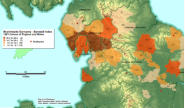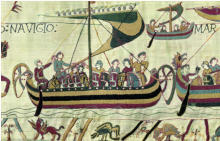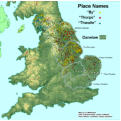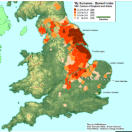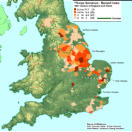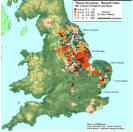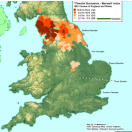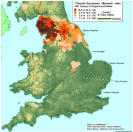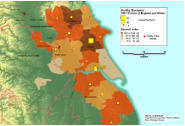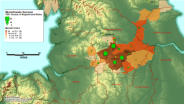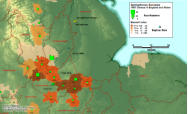
© J.H.Mathieson


Scandinavian Place Names and Surnames
The late 8th century witnessed a change in
strategy on the part of the Vikings. Rather than
seasonal raids aimed at plundering monasteries
ringing the Irish Sea, the focus shifted to
establishing permanent settlements. The
motivation is unclear. It may have resulted from
population expansion or the emergence of new
political alliances emerging at home. The upshot
was that for a period of time in the 9th and 10th century the Danes invaded the east and
north of England establishing settlements and political control in the region which later
came to be known as the Danelaw. Their settlement names bore either in full, or in part,
Scandinavian linguistic elements.
Scandinavian Place Names:
The most notable of these elements were place names containing by, thorpe and thwaite.
•
by - farmstead or village
•
thorpe - farm, dependent farm or village
•
thwaite - meadow, clearing or paddock
A relative settlement chronology of Danish place names was advanced by Professor
Kenneth Cameron. His research suggested that aside from places with purely Anglo Saxon
forms, those hybrids with a genitive Danish prefix and a Saxon suffix, were settled early,
and on better soil, likely reflecting the transfer of ownership from Anglo Saxon to Danish
Lords.
Subsequent settlement via the Humber River and the Wash represent colonization under
the protection of Danish armies which had come several generations earlier. This would
account for the large number of by places in the Five Burroughs on the best land and soil
available at the time of colonisation. Cameron further argued that thorpe settlements were
secondary and took place after the by settlements.
Gelling in the Landscape of Place-Names identifies thwaite (ON thveit) as indicating
“something cut down”. She noted that the qualifiers used as thwaite compounds;
support the concept of new settlements in marginal land. Some “thveits” were rough,
rocky, or stony, the dominant vegetation in some was bracken, broom, reeds or
sedge ….
As would be expected the distribution of
place names containing by and thorpe
largely fall within the territorial extent of the
Danelaw however places containing thwaite
to a large degree fall outside it’s northern
reaches in Cumberland and Westmorland.
The heaviest concentrations of by and
thorpe places are in the Northern Danelaw and the Five Boroughs. Accessibility provided
by the Humber riverine network was clearly at work in the region’s colonization. There is
also an eastern or coastal bias in play.
Scandinavian Surnames:
As expected the surname distributions closely
parallel the distribution of place name bearing
the same element. The maps to the left are
based on Banwell Indexes for each of the three
suffixes. The indexes were filtered to display
values =>2, in other words areas where the
surname suffix was represented at a level 2x
the national average. At this level the
distributions closely parallel the Danelaw
territory, particularly in the Northern and Five
Burrows districts. The Thwaite surnames are
most heavily concentrated outside the Danelaw
in the counties of Cumberland and
Westmorland with some representation in the
Northern Danelaw. It is noteworthy that the
distribution of place names and surnames
bearing the by element are under represented
in the Outer, Eastern and Southern Danelaw
regions. Professor Frank Stenton argued this
was the result of less intense settlement and
he pointed to presence of thorpes and Anglo
Danish hybrid place names as evidence
supporting this explanation. The presence of
thorpes, with the almost total absence of by place names, would represent later settlement.
Stenton noted;
They point to a state of society in which the immigrants from the North formed a
minority of the population, dominant, but too small to impress a purely Scandanavian
character on the names given to estates.
Surname exemplars
Holtby: The Village of Holtby is mentioned in the
Domesday Book as Boltebi in the Bulford hundred in the
possession of the King. At one point Holtby was held by
three thegns as three separate manors of six carucates.
Three carucates were at some point transferred to the
Priory of Durham. This may account for the existence of
Holtby and Little Holtby. In 1279 the Manor of Holtby
was exchanged by Adam de Holtby for the manor of
Walkingham in Kent. The Holtby surname is rare(1881 freq. 246), but still located in
Lincolnshire and the North Riding of Yorkshire in close proximity to the villages which are
likely the source of the surname.
Braithwaite: from the ON breithr, broad, thweit,
medow or cleared land. Several place names may
account for its origin in Cumberland, Westmorland, the
North and West Riding of Yorkshire. With a frequency of
3,464 in the 1881 census the surname is expressed
most heavily in Cumberland and Westmorland. A
Willelmus de Brathwayt is recorded in the 1379 Poll Tax
returns of Yorkshire.
Micklethwaite: Mikill or Micel means Large in ON,
and Thveit, again a meadow or cleared land. The
origin is thought by George Redmonds and David Hey
to be Banks Hall near Cawthorne.
Springthorpe: The place name Springethorpe
Lincolnshire appears in the Domesday book of 1066 as
Springetorp. The elements spryng, a spring or well and
thorpe, a dependent farm or village suggest a probable
meaning of a farm or village by a river or stream. The
19th century surname distribution is focused some
distance from the contemporary village of Springthorpe.
Parish records date the surname to the early 17th century near the centre of the 1881
distribution.
